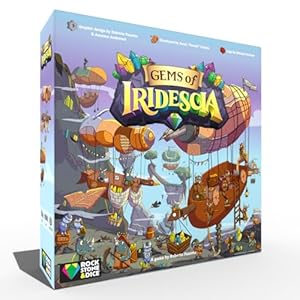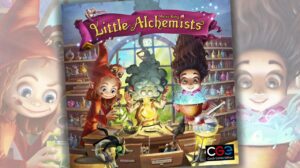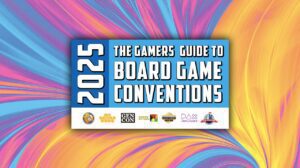Disclosure: Meeple Mountain received a free copy of this product in exchange for an honest, unbiased review. This review is not intended to be an endorsement.
Across three plays, there were a number of moments when I felt joy while playing designer Roberto Panetta’s luxurious 2025 release Gems of Iridescia. Published by Canada’s Rock, Stone & Dice, Gems of Iridescia comes in a deluxe edition that has all the fixins, from a linen-finished handbook to a fancy storage solution to gem tokens that shine just the right way in all kinds of light.
The artwork on the cards is cute. The back of the manual has a helpful “Pro Tips” section for new players. I think your best bet is to play Gems of Iridescia with its full complement of four players, but if you have less, a bot is included for use not only in solo mode, but also in a two- or three-player game to help round out your player count.
In terms of look and feel, I don’t think there’s a question that Panetta (a long-time gamer who has hit the scene with his first published design in Gems of Iridescia) got it right. While I wish the design hit more interesting high notes, Gems of Iridescia is on the right track for gamers looking for a very light exploration experience.
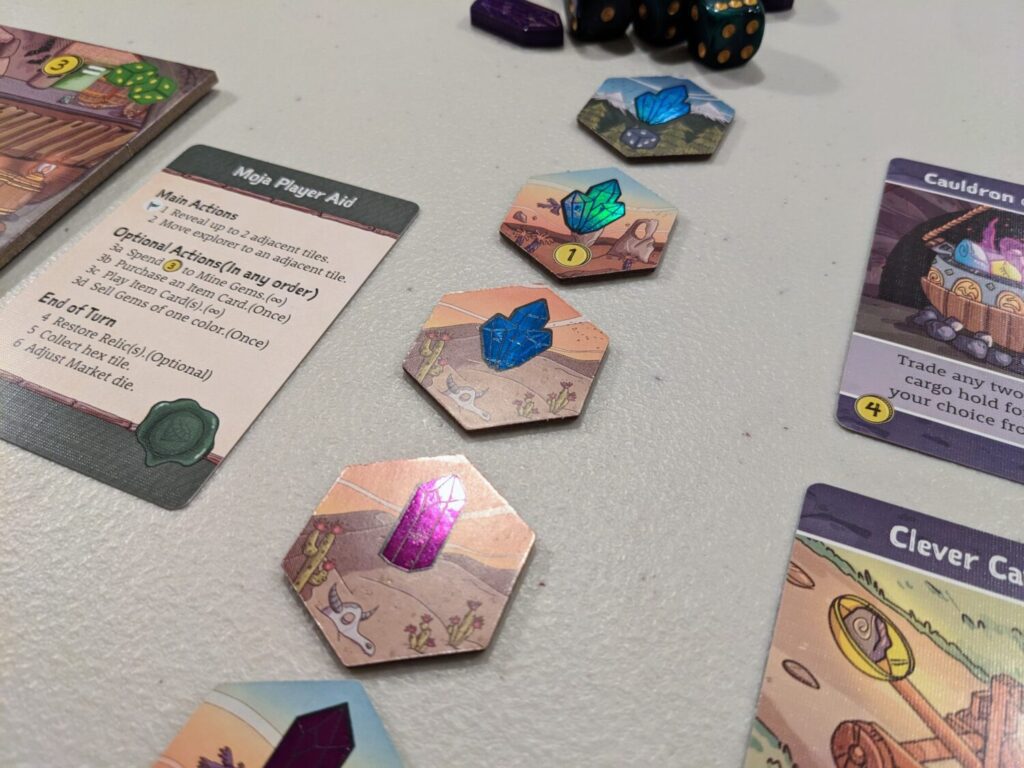
Go Sideways
Gems of Iridescia is an “order fulfillment” set collection game with very light market manipulation elements for 1-4 players that plays in about 20 minutes per player. Despite the game’s strangely-long 28-page rulebook (the pages are smaller, so maybe that’s helping me mitigate this conversation??), Gems of Iridescia is a very light, family-friendly tile-flipping game. Players take on the role of clan leaders exploring the world’s map, “lush with rare gems”, using their clan token to move northwards towards a row of castle tiles that will eventually trigger the end of the game.
On a turn, a player can flip up to two undiscovered tiles adjacent to their clan marker’s position. Then they must move onto one of those tiles, take the gem pictured (a gem in one of four colors, or a rainbow that grants a choice of any of the four gem types), then take a number of optional actions to mine more gems of the same color by chucking dice, buying an item card, selling gems of a single color, or using any number of item cards. At the end of a player’s turn, they can fulfill a gem market order by “restoring a relic” from a market row by turning in matching gems to score points; this is the main method to score points during the game.
When all players have reached the Castle row of tiles at the top of the board, the game ends. At this point, a player’s in-game tally is then added to a set collection score tied to certain sets of relic cards as well as gem tiles gathered during the game…the winner is the person with the most points.
While players are pushing north to trigger the end of the game, the reality in Gems of Iridescia is that the best way to score the most points is to slowly weave your way sideways to gather more gems (and, as the tiles get juicier later in the game, gem tiles feature both gems as well as coins, points, or additional dice used to boost the mining action) to fulfill more relic cards. In fact, one of the worst things you can do in Gems of Iridescia—and, a shout out to the Pro Tips section here—is to disregard the game’s title…this is a game about gems, specifically collecting gems, so taking the most turns to do that is the only way to fly.
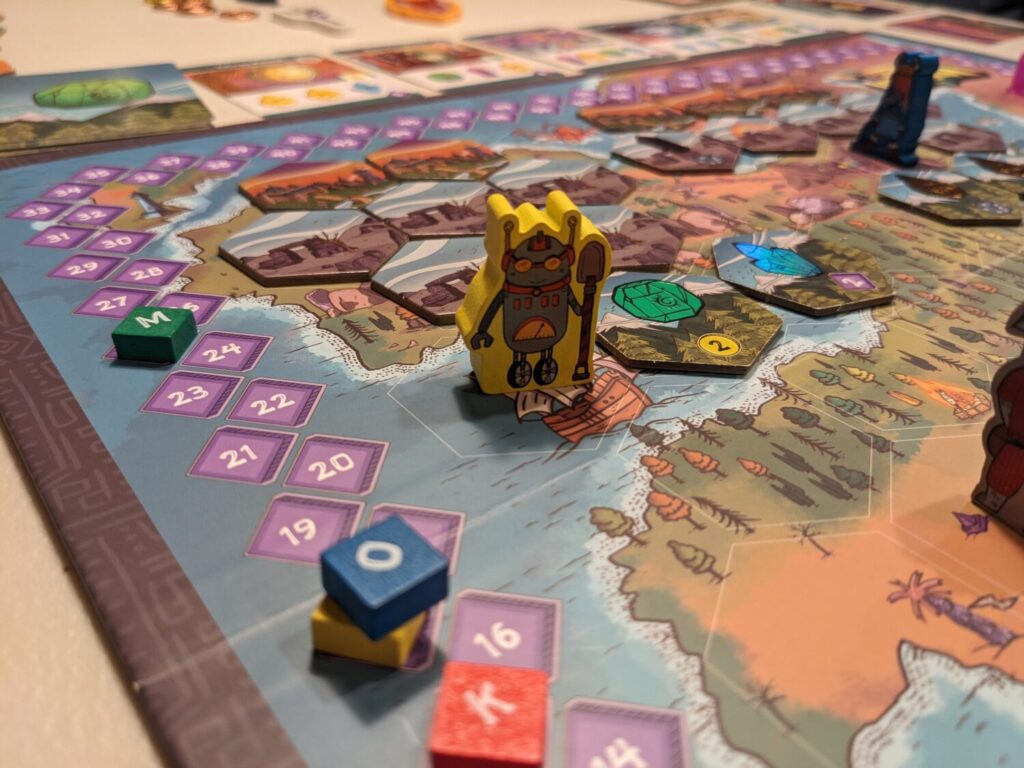
Diminishing Returns
I played Gems of Iridescia three times—first, solo (mainly to learn the game’s systems), then a three-player game, then a four-player game with my review crew. Gems of Iridescia is available on Board Game Arena, so I did my three-player game online, and that play provided a few insights.
The first of those insights was that turns were sometimes—eventually, often—quite bland. Moving up the board to flip a tile and take a gem? Fine. Gems of Iridescia feels like a family game, in part because there are no teeth to the tile discovery process…each tile definitely has a single gem pictured on it. No doubles, no penalties, no tiles without a gem. It’s just a question of which single gem is pictured, so players are always going to get something.
While the item cards provide a light amount of dynamism to the market—mainly in the form of the Lucky Libation card that allows a player to roll the Gem Market dice to shake up their current values—the market in this game is very steady, and is always going up. That means that at the start of the game, a single gem can be added to a player’s supply for free during the movement action, then mined for a cost of three coins to get as many as two additional gems. They can be sold for two coins each (the values for each gem are set at two during setup), and at the end of each turn, the value of the gem pictured on the selected tile goes up by a coin. When a die is wrapped from six back down to one, you might say the market “crashes”, but on the active player’s turn, they will be able to sell at the high price before the crash.
This led to much less drama than I was hoping for. Money ended up being plentiful by the mid-game in each of my multiplayer games, and because savvy players are moving sideways around the board to hoover up as many gems as they can before moving north (southward movement is not allowed), everyone has everything they need, if they want. Worse, the relic market is five cards wide. Often, almost by accident, you are going to have the right gems to solve at least one of the relics at the end of each turn, unless you’ve decided to specialize in a gem type, likely to make a lot of money on a single sale.
One could argue that the ease of gem acquisition is a benefit, and for some players—particularly those playing this with their kids, which I could absolutely see as a win since I have kids of my own—that means Gems of Iridescia might be worth a look. The game is certainly never mean; even when a player gets to the top of the board and exits the game, the most they can do to negatively affect opponents is to remove tiles from the board when their turn comes around, which we found to also be a pretty weak alternative. The game penalizes players who are left unable to move to an adjacent tile by taking one of their gem tiles away, but they still get to move and take another turn…meaning that player will still get a tile back during their main action.
I wanted to see how that played in the four-player game, so I decided to race up the board and take the game’s minimum nine turns. I got absolutely demolished by the other players; the winner in that game beat me by 30 points, and it should have been worse. Even three plays in, I can’t see any reason why a player would race up the board, especially in games with a lower player count. That’s because there is much less interaction even at three players than four, with an entire map to dig around in to gather as many gem tiles as a player might desire.
The funniest thing about racing up the board first—I basically had nothing to do for about 25 minutes in that game, using my turn to simply toss a tile from the game, which never hurt any of the other players.
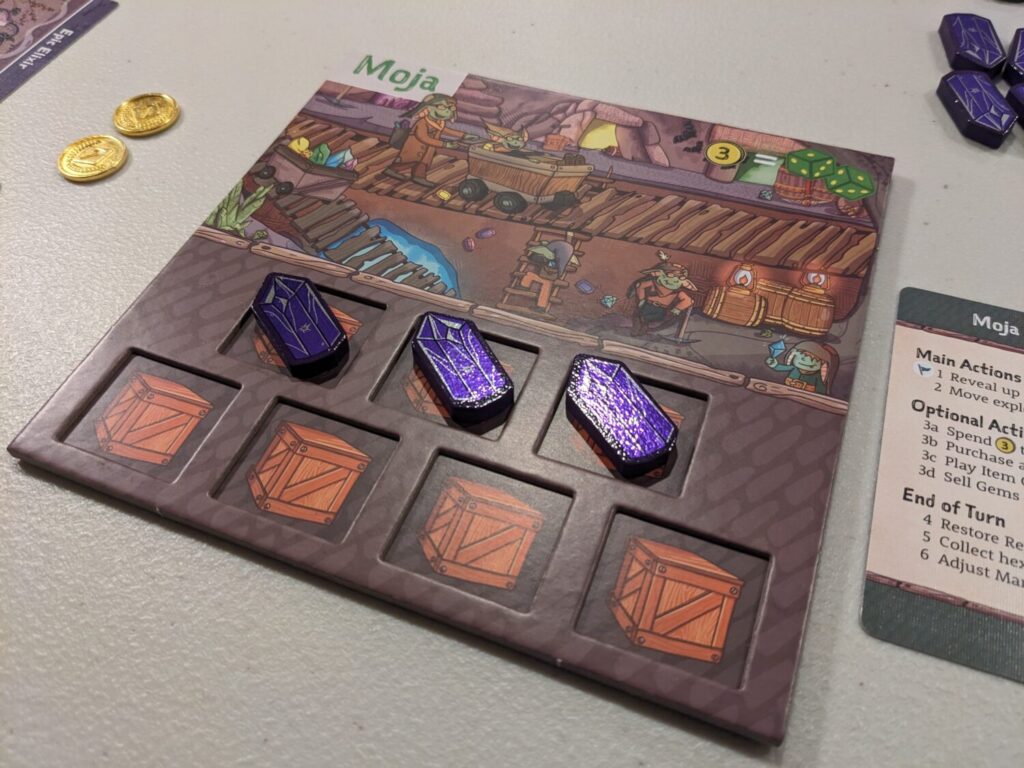
A Hole in the Market
Gems of Iridescia had its fun moments, especially as I began to discover the game’s systems. This experience reminded me of my plays of the CGE game Starship Captains from a couple years ago. With that title, my first play was the best one, and each play afterwards was a little less interesting. Gems of Iridescia gave me similar vibes.
That’s not to say that it is not for anyone…in fact, I think the target audience here is casual gamers (who we refer to as “muggles” in my circles) or serious hobbyists who want a few titles in their collections that they can break out with casual players. Despite a setup that is a little clunky—each gem tile has to be specifically placed in one of five different zones based on the illustration on the back—Gems of Iridescia is really easy to get to the table. Our four-player game took 75 minutes, and even if we played it a second time in my review crew, I’m sure the entire game could wrap in under an hour.
I also think Gems of Iridescia is a great fit for a parent looking for a title that fits players in that 8-12 year-old range. The illustrations by Sarah “Freedz” Conlon are great and give the sense of a fantasy world that I think kids will love.
For a seasoned strategy gamer, Gems of Iridescia was less interesting for me, and three plays is probably enough. Panetta’s first design gives me hope that his next title will have more strategic variety in its gameplay.



